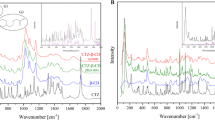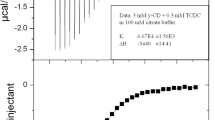Abstract
Fendiline (N-[1-phenylethyl]-3,3-diphenylpropylamine hydrochloride, trade name: Sensit) is a β-receptor blocker and a Ca antagonist. It is a viscous oil and even its crystalline hydrochloride is a very hydrophobic and sparingly soluble compound in water.β-Cyclodextrin complexes fendiline base in a molar ratio of 2∶1. In aqueousβ-cyclodextrin solution, the significantly increased solubility and the intensive induced circular dichroism prove the formation of true inclusion complexes with both the base and the hydrochloride. In artificial gastric juice, the solubility of the complexed forms of the fendiline base and its hydrochloride is 40 and 22 times higher, respectively, than that of free drugs. The complexation withβCD resulted in a two-threefold increase in the rate constants of diffusion and absorption determined in a Sartorius apparatus.
Similar content being viewed by others
References
Hungarian Patent 150534 (1961).
J. Szejtli:Die Stärke 33, 387 (1981).
J. Szejtli and L. Szente:Die Pharmazie 36, 694 (1981).
J. Szejtli, A. Gerlóczy, and A. Fónagy:Die Pharmazie 38, 100 (1983).
J. Pitha, L. Szente, and J. Szejtli: inControlled Drug Delivery Vol.1 (ed.: S. D. Bruck); p. 124, CRC Press, Boca Raton, Florida, (1983).
K. Koizumi and Y. Kidera:Yakugaku Zasshi 97, 705 (1977).
K. Uekama, N. Matsuo, F. Hirayama, T. Yamaguchi, Y. Imamura, and H. Ichibagase,:Chem. Pharm. Bull. 27, 398 (1979).
Hungarian patent 178755 (1979).
J. Szejtli:Cyclodextrins and their Inclusion Complexes, Akadémiai Kiadó, Budapest (1982).
M. Kajtár, Cs. Horváth Toró, É. Kuthi, and J. Szejtli:Acta Chim. Hung. 110, 327 (1982).
H. A. Benesi and J. H. Hildebrand:J. Am. Chem. Soc. 71, 2703 (1949).
H. Stricker:Pharm. Ind. 33, 157 (1971).
H. Stricker:Drugs in Germany 14, 93 (1971).
M. Kurcz, V. Pálosi-Szánthó, K. Urbán Szabó, K. Lánczi-Ács, and M. Kucsera:Symposium of the Hungarian and Polish Pharmacol. Soc. on Pharmakokinetic Aspects of Drug Research, Visegrád, 15–18 May 1983 (Hungary).
M. Kurcz, K. Tòth, and U. Pálosi-Szánthó: inNew Approaches in Liquid Chromatography (Ed.: H. Kalász), Akadémiai Kiadó, Budapest (in press).
Author information
Authors and Affiliations
Rights and permissions
About this article
Cite this article
Stadler-Szöke, Á., Vikmon, M., Szejtli, J. et al. Fendiline-β-Cyclodextrin inclusion complex. Journal of Inclusion Phenomena 3, 71–84 (1985). https://doi.org/10.1007/BF00658864
Received:
Issue Date:
DOI: https://doi.org/10.1007/BF00658864




